Fast forward back to Paris: having just completed my jog, I am excitedly staring
at the clock in the hotel room and wanting time to pass quickly so I can board
the train to Champagne and be on my way. My wife,
Michelle, sensed my restlessness and suggested that I go the train
station and get on an earlier train. This would allow me to walk around Epernay
or even wander across the street from Philipponnat in Mareuil-sur-Ay to pay
Marc Hebrart a visit. I thought this to be an excellent idea so I
headed out early for the train station.
I got to the station and inquired if it would be a problem if I
boarded an earlier train. They told me it would be no problem at all and I was
on my way to the ticket retrieval machine. Before leaving for France, I had
bought my train tickets on-line so that I could walk into the station and
quickly retrieve them with the credit card I had used to purchase them. Shaking
with anticipation because I could already taste the Clos des Goisses, I pulled
my credit card from my wallet and swiped it through the ticket retrieval card
reader. It beeped at me and told me that it didn’t recognize the card. I tried
again; same thing. I then tried a different card and it said that it wasn’t on
file so I finally gave up and made my way back to information desk where they
explained that I purchased my ticket on-line with my Bank ATM/Debit/Credit Card
and that the machines here only read traditional US based Credit Cards. They
told me that I would need to go to the main terminal desk and ask for a paper
ticket to be issued. So I trudged along to the main desk expecting to be quickly
back on my way. If only it were that simple.
As I walked into the terminal, I noticed that only two attendants were working
(even though there were around 10 spots and a seemingly endless supply of
workers buzzing in the background and talking to each other). Still, this didn’t
worry me as I had 2 hrs until the train I bought a ticket for was scheduled to
leave and the line wasn’t that long (only about 8 people). Well, the line
proceeded to crawl along at the slowest pace I have ever seen. Each person who
went up to the counter seemed to tell their life story to the attendant and to
make things worse, every time a new worker entered into the attendant desk area,
everyone would get up and hug and kiss each other to celebrate the new arrival
of a co-worker (they should have popped a bottle of bubbly the way they were
celebrating). I had never seen anything like this before. If I did this at work,
I would get nothing done. I began to worry as I was now down to less than an
hour and there were still four people in front of me. I wanted to scream as I
could see the attendant morph into an the evil Clos des Goisses Nazi and
cackle at me, “No Clos for you!”
Finally, I made it to the counter and had my ticket with less than 10 minutes to
spare. I hopped on my train and was on my way. It is somewhat ironic that I
thought I had everything planned so well and managed to screw everything up, yet
my excitement led me to throwing out my original plans and arriving much earlier
than expected to the train station. It was this unplanned extra time that saved
my bootie. Some things are meant to be and I was meant to walk the Clos!
 Squeaking wheels declared my journey to Epernay complete. A quick taxi whisked
me to Mareuil-sur-Ay and there it was - a beautiful building with Philipponnat:
Clos des Goisses written on the front of it. I rang the bell and was escorted
upstairs and introduced to Vianney Gravereaux and
Charles Philipponnat (head of the house and the 16th generation of
the Philipponnat family to be involved with the wines).
Charles Philipponnat, pictured
at left, and I battle in my favorite game: Guess the vintage of Clos des
Goisses.
Squeaking wheels declared my journey to Epernay complete. A quick taxi whisked
me to Mareuil-sur-Ay and there it was - a beautiful building with Philipponnat:
Clos des Goisses written on the front of it. I rang the bell and was escorted
upstairs and introduced to Vianney Gravereaux and
Charles Philipponnat (head of the house and the 16th generation of
the Philipponnat family to be involved with the wines).
Charles Philipponnat, pictured
at left, and I battle in my favorite game: Guess the vintage of Clos des
Goisses.
We started our exploration by walking through the Clos des Goisses. This
vineyard is a complete freak of nature and probably the definition of perfect
terroir in Champagne. The most famous part of this vineyard is the south facing
slope that is so steep that nets must be put up during harvest time to catch the
workers who lose their footing and tumble down the slope. This southern facing
slope gets intense sun which brings very ripe grapes. This means that in poor
vintages, Philipponnat can often harvest ripe grapes from this area and make
very good, but limited wine (2,500-10,000 bottles). So, what about the very ripe
vintages? Well, this is where the eastern facing, cooler portion of the vineyard
helps out. In very hot years, the less famous eastern facing vineyard yields
grapes that balance out the super ripe southern facing grapes and make not only
a spectacular wine, but one of good volume (30,000 + bottles). While the sloping
vineyards and varying exposures give the vines a spectacular place to grow
during the day, the vineyards are also situated perfectly for nights. Because of
the location in the Marne Valley near the Marne Canal and the slight elevation,
the nights are quite cool as the winds sweep through to cool the vines and keep
the mold at bay.
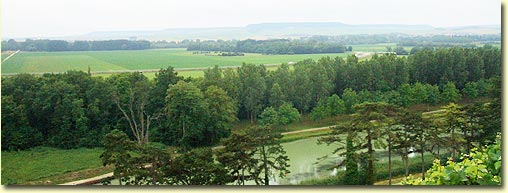
A view
from the top of Clos des Goisses.
You may not be able to tell, but the vineyard is so steep that nets need to be
set up to catch falling workers.
We made our way through each of the blocks of the Clos des Goisses vineyard and
I learned that Philipponnat is quite strict with its vine selection for Clos des
Goisses. Until the vines are 13-16 years old the grapes either go unused or are
used for blending in other cuvees. When you factor in the average time it takes
a vintage of Clos des Goisses to reach the market after harvest (9 years), this
means that Philipponnat cannot even begin to recoup any of their vine
investments for almost 25 years.
While walking, Vianney and I got to talking about sports and we discovered that
he was a rugby player and I was a wannabe American football player. We each
thought that the other’s sport was more violent as Vianney said that Rugby
players knew their limits as they didn’t have pads, but that NFL players felt
safe with pads and often did some not so smart things. I disagreed and said that
rugby players (along with Aussie Rules Football players) were crazy and they had
injuries and missing teeth to prove it. We agreed to disagree, but since then
the story of
the rugby player with a tooth lodged in his head for a few months has
come out. Hey Vianney, I win. This proves rugby players are the craziest!
Before leaving the Clos des Goisses, I was handed a piece of chalk and told to
taste it. Now I’m not a chalk connoisseur as I haven’t had any since I was 6 or
7 years old, but this was mighty tasty chalk (and I’m not a fan of chalk flavors
in my Champagne). Surprisingly, I found this same flavor in many of the
Philipponnat cuvees we later tasted. More than anything else, this tasting
experiment drilled home that the house style of Philipponnat is all about fresh
fruit mixed with bright minerality and a clean finish. After tasting the chalk,
I looked down and discovered that the topsoil in the Clos des Goisses is only a
couple centimeters thick. After these 1.5 to 3 centimeters of dirt it is solid
chalk. In fact, in some places, I noticed there was no topsoil. It was pure
chalk. This is good for the vines as the chalk can hold water in rainless times.
Just one more reason that this vineyard is perfection defined.
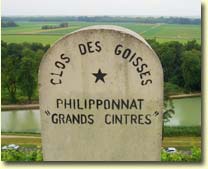
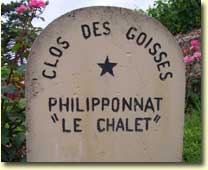
The blocks of Clos des Goisses… How about
breaking it down even further than a single vineyard bottling?
Our tour of the vineyard now done, we made our way through the facility and I
was impressed at how new everything was. Charles Philipponnat pointed out that
before he joined, quality was not at the top of the list. He helped to usher in
not only a new facility that was more centrally located to all of Philipponnat’s
vineyards, but one that housed new equipment and used common sense and more
flexibility with winemaking. In the past, many of the wines were fermented in
only stainless steel. Charles helped to change this as the NV reserve wines are
now stored in an oak solera, more oak is being used in the vintage wines, and
attention is being paid to barrel size and quality for all wines. Philipponnat
is also paying close attention to the dosage as they want to let the naturally
bright fruit and minerals shine through. In fact, they are paying such attention
to quality that they have no problem changing the dosage in the middle of a
vintage release if they think that the wine will benefit from it. This is the
kind of flexibility that I like and wish other producers followed. After all,
producing the best possible product should always be the goal. This point was
really driven home to me as he explained how pre-2000 vintages of Clos des
Goisses were produced. If you think Clos des Goisses is a great wine today, wait
until you see what the vintages from the 21st century bring.
As we made our way to the tasting room we talked about what details should be on
the wine label. To my surprise, Philipponnat was all for including information
detailing grape makeup, disgorgement, dosage, base vintage for NV blends,
reserve wine % for NV blends, and anything else the consumer might want. I asked
them why I can’t find this information on the bottles I buy in the US and
Vianney and Charles chuckled and told me that they had to remove it to put on
all of the US required alcohol warnings. They would love to put it on the label,
but there just isn’t enough space on bottles bound for the US. They can fit on
the disgorgement date, but not much else.
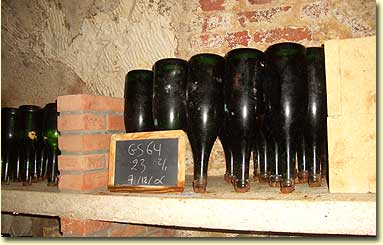
The dwindling treasure cellar. Anyone for a
Magnum of 1964 or 1976 Clos des Goisses?
Just before we reached the tasting room, we made a quick detour to visit the
quickly shrinking treasure cellar of older vintages of Clos des Goisses. I was
surprised at how few bottles existed and also that nothing prior to 1943 was
present. Charles explained that the Germans destroyed all pre-1943 vintages in
World War II and that in past years, the house was too generous in handing out
old vintages. It has all resulted in very few bottles prior to the 1990s.
Philipponnat is planning to keep quite a few of these bottles so they aren’t for
sale at any price. This means the already supply strapped market is only going
to see even more demand for old vintages of Clos des Goisses (so if you see a
bottle, pick it up; you might not see it again).
With that, we entered the tasting room and the wine flowed. Most of what we
tasted is detailed below. As we were tasting, Vianney and Charles mentioned that
a few new twists were coming from Philipponnat and the Clos des Goisses. A Clos
des Goisses Rose is one example. The 1999 (approximately 1,000 bottles produced)
is the first vintage of what will be a somewhat regular release (released not
quite as often as the white Clos des Goisses, but rather whenever the vintage
has given them good raw materials). But other new adventures are also planned.
Trust me, Philipponnat is making better and better wines and the portfolio will
not only get better but widen (if the wines are deemed fit) as well.
NV Reserve Wines
(Mix of Chardonnay, Pinot Noir, and Pinot
Meunier fermented in stainless steel and aged in an oak solera – some of the
wines were aged in stainless steel before entering the oak solera; this is a mix
of various years)
Quite striking in acidity and full of bright pears with a touch of cream and
mineral. This is drinking surprisingly well and shows a clear relationship to
the Royale Reserve below. I’m not sure this should taste quite so good and
Philipponnat was also surprised at its drinkability, but time will be final
judge as it will be a few years before any bottles are released that utilize
this solera.
For those of you unfamiliar with tasting Champagne before its second
fermentation, it shouldn’t taste much like a wine you would want to go to the
store and purchase. It is normally quite acidic, a bit unripe, and just missing
that “something” as it has to wait until the second fermentation to strut its
stuff. In my experience, when the wines taste great after the first
fermentation, they don’t have the stuffing to shine after a second fermentation.
This is especially true with vintage wines as the still wine doesn’t get a
chance to age and grow. It goes right into the bottle to start the second
fermentation while reserve wines meant for NV blending have time to age as a
still wine. This means that some older reserve wines can be somewhat attractive.
However, this solera of reserves seemed almost too attractive. Still, we need to
remember that this will only be a portion of the final NV cuvee so any
characteristics it has can either be brightened or dimmed by the blending. Also,
please remember that there is a difference between wine meant to become
Champagne and wine meant to be sold as a still wine from Champagne like
Coteaux Champenois and Rose des Riceys (both of which can sometimes
be quite good).
***Note: I don’t score still wines meant to be Champagne, I simply describe
them. After all, these wines were never meant to be nor will they ever be sold.
However, they do provide a fascinating glimpse into the Champagne process.
 NV Royale Reserve Find this wine
NV Royale Reserve Find this wine
(30% Chardonnay, 45% Pinot Noir; 25% Pinot
Meunier; 50% 2003 base wine with 50% reserve wines from a solera of mixed
vintages; All wines fermented in stainless steel; Reserve wines aged in an oak
solera and some stainless steel; Disgorged September 2006; 8 g/L Dosage; $35-45
US)
Never a favorite of mine in the past, this has grown leaps and bounds as toasty
pears, fresh apples, and peaches highlight a bright fruit palate that has gentle
kisses of cream and minerals. A solid effort that, more than any other wine,
shows the progress Philipponnat has made since Charles Philipponnat took the
reins. Grade of Low B (82-84 pts)
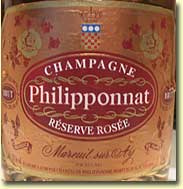 NV Reserve
Rosée Find this wine
NV Reserve
Rosée Find this wine
(35% Chardonnay, 55% Pinot Noir; 10% Pinot
Meunier; 2002 base wine; Red wine addition; All wines fermented in stainless
steel; Reserve wines aged in an oak solera; Disgorged September 2005; $35-45 US)
A subdued nose of creamy strawberries, biscuit dough, and striking minerality
jumps out at me and leads into an elegant and tasty palate. Flavors of slightly
racy dough, darker leaning red berries, and red citrus juice poured over
minerals lead into a long finish that evokes memories of how Pop Rocks ™ feel
(not taste) in your mouth. A wonderful, inexpensive introduction into the
Philipponnat house style of fresh fruit and clean minerality. This drinks a good
deal above its price point. Grade of High B (85-87 pts)
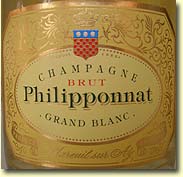 1999 Grand Blanc Find this wine
1999 Grand Blanc Find this wine
(100% Chardonnay; All stainless steel
fermentation and aging; Disgorged September 2006; 5 g/L dosage; $55-70 US)
Bright fresh citrus, minerals, and bread notes make up a very fragrant nose. The
palate follows along with juicy pears and fresh bread making for a very open
wine. I really like the choice of dosage here as it works well for the open 1999
vintage and mineral driven house style. Earlier disgorgements of this wine were
done with a dosage of 8 g/L and had a somewhat dull and heavy character to them.
This wine is bright and singing. While I often prefer higher dosages in my
wines, this is one instance where the wine demanded a lower one. Philipponnat
understands that flexibility is key and I applaud them for that.
Grade of B+ (87-89 pts)
 2000 Cuvee 1522
Find this wine
2000 Cuvee 1522
Find this wine
(40% Chardonnay, 60% Pinot Noir; Grand Cru;
Disgorged February 2006; 4 g/L dosage; $65-90 US)
The 1522 wines are the tete de cuvees of Philipponnat’s house style. Named to
commemorate the date that the Philipponnat family first owned vineyards in
Champagne, the grapes in this cuvee come from various Grand Cru vineyards that
Philipponnat owns and sources. This was formerly a NV blend, but starting with
the 2000 vintage, it now bears a vintage date. I’m glad that it does as the 1522
is a very nice wine.
This has a big and bold nose full of spicy meaty citrus and red tinged pears.
The palate steps back from the forward style of the nose as the flavors are
rather elegant with clean citrus and a stunning dose of minerality.
Grade of B+ (87-89 pts)
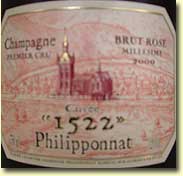 2000 Cuvee 1522 Rose Find this wine
2000 Cuvee 1522 Rose Find this wine
(35% Chardonnay, 65% Pinot Noir; Grand Cru; 6-7%
red wine added to the white Cuvee 1522; Disgorged August 2006; 4 g/L dosage;
$65-90 US)
If there is one wine I would pick to describe the true style of Philipponnat it
would be this one. While Clos des Goisses is clearly the star of the house, it
isn’t the best example of what Philipponnat is all about. After all, the Clos is
so unique and special that the main job of the winemaker is to not mess up what
the earth has given. With this wine, blending is a key factor and the winemaker
can work his magic.
As with the 2000 vintage of Cuvee 1522 Brut, this shows meaty notes on the nose,
but a good dose of strawberries and minerals join in as well. The palate shows
fresh strawberry-citrus juice, chalky minerals, and some just forming biscuit
notes. A long and clean red citrus and mineral finish has me reaching for
another glass. This is a very good wine and an excellent effort for the 2000
vintage. Grade of Low A- (89-91)
1995 Clos des Goisses Find this wine
(35% Chardonnay, 65% Pinot Noir; Single vineyard
in Mareuil-sur-Ay; Steel and oak fermentation & aging; No malolactic
fermentation; Disgorged February 2006; 4.5 g/L dosage; Production of ~5,000
bottles; $125-$150)
This wine shows some of the characteristics of the 1996, 1997, and 1999 Clos des
Goisses (described below). The nose shows some of the power of the 1996 mixed
with the open citrus and meaty minerality of the 1999. In the mouth, racy
flavors of pear, apple, and gentle almonds remind me a bit of the 1997. A few
toasty dough notes also come into play and are quickly met with a spunky citrus
that wants to put up a fight and keeps fighting through a long and creamy citrus
and mineral finish. While this isn’t quite at the level of the 1996, it is a
very nice drink and one that takes you on quite a ride with its feisty flavors.
I ran into quite a few people in Champagne who preferred it to the 1996 for
current drinking strictly because of this reason. Grade
of Low A (92-94 pts)
1996 Clos des Goisses Find this wine
(35% Chardonnay, 65% Pinot Noir; Single vineyard
in Mareuil-sur-Ay; Steel and oak fermentation & aging; No malolactic
fermentation; Disgorged April 2006; 4.5 g/L Dosage; Production of ~30,000
bottles; $125-$150)
This is one heck of a powerful wine. Tart citrus, hard pears, and a racy toasty
aroma highlight a nose that can be smelled across the table. Hardcore
concentrated citrus forms the backbone for other flavors of toast, biscuit,
pear, and yellow apple to bloom from. And the finish, well, I think I can still
taste it.
I love this wine; it is one of the best wines from 1996, one of the best Clos
des Goisses, and maybe one of the best wines ever made. It is drinking better
now than it did on release and as such, I have upped my score on this for both
current (from A- to A) and potential drinking (from A/A+ to A+ ). I highly
encourage you to try this young for the experience and then hide the rest of
your bottles away under lock and key so you don’t drink them for another 20
years. One final note, word on the street has it that the April 2006
disgorgement of this wine is superior to other disgorgements. I cannot verify
this as I have only tried and own the April 2006 disgorgement, but it may be
worth picking up this disgorgement if you have a chance.
Grade of A for today (93-95 pts) with A+ potential (97-100
pts)
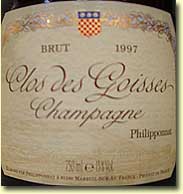 1997 Clos des Goisses Find this wine
1997 Clos des Goisses Find this wine
(35% Chardonnay, 65% Pinot Noir; Single vineyard
in Mareuil-sur-Ay; Steel and oak fermentation & aging; No malolactic
fermentation; Disgorged March 2007; 4.5 g/L Dosage; Production of 5,000 bottles;
$140-$165)
A toasty nose initially gives off some clean citrus notes, but with time opens
up to show some almond characteristics. For me, the highlight of the palate was
some unsweetened almond paste that winds its way around citrus and pear notes.
This is the heaviest of the Clos des Goisses that I tasted and also the most
mysterious. A very nice wine to drink now or cellar for the next decade or two
as the suspense in how this will change with age grows every day.
Grade of Solid A- (91-92 pts)
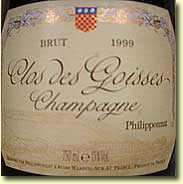 1999 Clos des Goisses Find this wine
1999 Clos des Goisses Find this wine
(35% Chardonnay, 65% Pinot Noir; Single vineyard
in Mareuil-sur-Ay; Stainless steel and oak fermentation & aging; No malolactic
fermentation; Disgorged March 2007; 4.5 g/L Dosage; Production of 30,000
bottles; $140-$165)
The nose on this wine blew me away with its open aromas of big citrus, meaty
minerality, and yellow apples. Not wanting to show that it can’t keep up, the
palate is just as open for business with a complex mix of pears, cream, and
bright yellow apples. A very long finish of lightly oaked pears and creamy sweet
citrus drives this wine home.
Philipponnat has released this vintage a bit younger than they usually release a
Clos des Goisses, but the wine called for it. This is the most open and ready to
go of the Clos des Goisses noted here; it has the least blooming to do in the
future. I would recommend popping this and letting your other vintages sit, age,
and improve. Grade of Solid A- (91-92 pts)
Cheers!
Brad Baker
Philipponnat |
Veuve Clicquot | Vilmart |
Jacquesson | Ruinart |
Goutorbe Part 1
Goutorbe Part 2 |
Henri Giraud | Chartogne-Taillet | Introduction
BACK TO THE TOP
BACK TO BRAD BAKER'S
INDEX PAGE
September, 2007 © Brad Baker


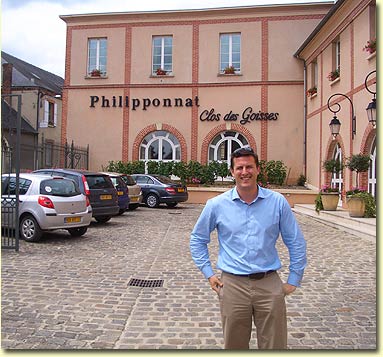
 Squeaking wheels declared my journey to Epernay complete. A quick taxi whisked
me to Mareuil-sur-Ay and there it was - a beautiful building with Philipponnat:
Clos des Goisses written on the front of it. I rang the bell and was escorted
upstairs and introduced to Vianney Gravereaux and
Charles Philipponnat (head of the house and the 16th generation of
the Philipponnat family to be involved with the wines).
Squeaking wheels declared my journey to Epernay complete. A quick taxi whisked
me to Mareuil-sur-Ay and there it was - a beautiful building with Philipponnat:
Clos des Goisses written on the front of it. I rang the bell and was escorted
upstairs and introduced to Vianney Gravereaux and
Charles Philipponnat (head of the house and the 16th generation of
the Philipponnat family to be involved with the wines).




 NV Royale Reserve
NV Royale Reserve  NV Reserve
Rosée
NV Reserve
Rosée  1999 Grand Blanc
1999 Grand Blanc  2000 Cuvee 1522
2000 Cuvee 1522
 2000 Cuvee 1522 Rose
2000 Cuvee 1522 Rose  1997 Clos des Goisses
1997 Clos des Goisses  1999 Clos des Goisses
1999 Clos des Goisses